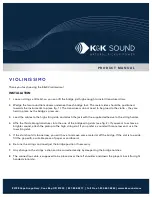
1.5 Main Fuctions
1. Parameter configuration interface is simple and easy to operate.
2. Adjustable Live A-scan waveform display, control of Gain, Blanking, Gate,
Range and Delay etc.
3. Time-based B-scan function, displays a cross section of the test piece, for
observing the underside outline of the workpiece.
4. Numerical view, display thickness values with big digit.
5. Thickness alarm: programmable High-Low alarm set point with dynamic
change thickness value’s color.
6. Limit value mode: catching the minimum and maximum values when
measuring.
7. Difference mode: getting the difference between the actual value and the
normal value as well as the percentage of difference value and normal value.
8. Selectable units of mm and inch.
9. Optional resolution:
×
.
××
mm /
×
.
×
mm;
×
.
×××
inch /
×
.
××
inch.
10. Optional waveform style: outline mode or fill mode
11. Optional rectification mode: RF+, RF-, full wave, half +, half -
12. Language: Chinese, English, German, French, and Japanese,
multi-languages available.
13. Approx. battery life: 24hours.
14.Great capacity data storage function: Stores 100,000 thickness
values&1000 waveforms(only UM-5DL).
15.Measure the net thickness of the workpiece through the coating layer (only
UM-5D&UM-5DL).
2.Keyboard Functions
There are 9 keys on the keyboard totally, including 3 virtual function keys
(
), four direction keys (
), two
specialized function keys (
). See the following illustration (2.1)
2.1 KEYBOARD FUCTION ILLUSTRATION
3.
Measuring Thickness
3.1Instrument Calibration
Before using UM-5 series, the instrument and probe must be calibrated.
Purpose of calibration is performing probe zero procedure and obtain the
sound velocity of the material being tested. And it’s important to set up the
correct probe model firstly before the calibrating process. UM-5 series’
calibration divided in to the following:
1.Probe zero procedure
:
Use the zero block on the instrument to set up the
probe zero procedure.
2.One point calibration
:
Use the zero block on the instrument to set up the
probe zero procedure first, then obtain the velocity from the test block of
known thickness.
3.Two point calibrations
:
Calibrate the probe zero and the velocity of test
block from two known thickness and same material standard blocks.
5
6

































